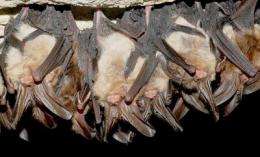New research highlights: 'Conservation and Management of Eastern Big-Eared Bats'

A new publication from the USDA Forest Service Southern Research Station (SRS), 'Conservation and Management of Eastern Big-Eared Bats,' brings together the latest knowledge about eastern big-eared bats. Edited by SRS researcher Susan Loeb, University of Kentucky professor Michael Lacki, and Weyerhauser manager Darren Miller, the publication features proceedings from a 2010 symposium.
The publication represents the first synthesis of this information, much of it previously unpublished, on one of the most common group of bats in the eastern United States. All of the eastern big-eared bat species are of special conservation concern and at risk due to habitat loss, disturbance to caves and summer maternity sites, environmental contaminants, genetic isolation, and disease.
Over the last decade a group of managers and scientists started meeting informally to develop guidance on how to secure or improve habitat for this group of bats. In 2007, they held the first meeting of the Rafinesque's Big-Eared Bat Working Group, where participants agreed that there was not enough synthesized knowledge about this species to inform management.
"A lot of information that could be of great use to the biologists and managers of state, Federal and tribal lands that harbor these bats was literally in filing cabinets and desk drawers," said Susan Loeb, SRS research ecologist and expert in bats of the Eastern United States. "We realized that a similar situation probably existed for the other eastern big-eared bats, so we held a symposium to encourage researchers to present and publish new information and synthesize existing knowledge."
The fifteen chapters of the symposium proceedings include information on biology, ecology, and status of eastern big-eared bats, as well as discussions of conservation and management strategies. "In publishing these proceedings, we wanted to provide an easily accessible publication that managers and biologists can use to draft management strategies and policy," said Loeb. "We also aimed to further the understanding of the ecology of these important and less-studied species."
Once you've seen them up close, big-eared bats are hard to forget. Their ears are indeed large, sometimes a quarter of the animal's total length. Big-eared bats are also sometimes known as "lumpy-nosed" bats because of the mitten-shaped glands that lie on either side of their noses.
Because of their looks, big-eared bats (genus Corynorhinus) are some of the most recognizable bats of the Eastern United States, in a range that extends from West Virginia to Texas and includes Rafinesque's, Virginia, and Ozark big-eared bats.
Over the past two decades, research on bats in general has increased greatly, as has public understanding – even fascination with—these small nocturnal animals. Much of what is now known comes from studying forest bats using acoustic detectors that pick up the echolocation calls, the sounds bats send out to navigate and find insect prey in the dark.
"Unfortunately, much less research has been done on big-eared bats," said Loeb, SRS research ecologist and expert in bats of the Eastern United States. "Big-eared bats are 'whispering bats,' which means it's hard to record their echolocation calls with acoustic detectors. They're also relatively rare, and difficult to capture because of their high maneuverability."
Because of these limitations on research, relatively little is known about the size and nature of communities of big-eared bats, their favored habitats, and their responses to forest management.
More information: Access the full text of the proceedings: www.srs.fs.usda.gov/pubs/39814
Provided by USDA Forest Service


















